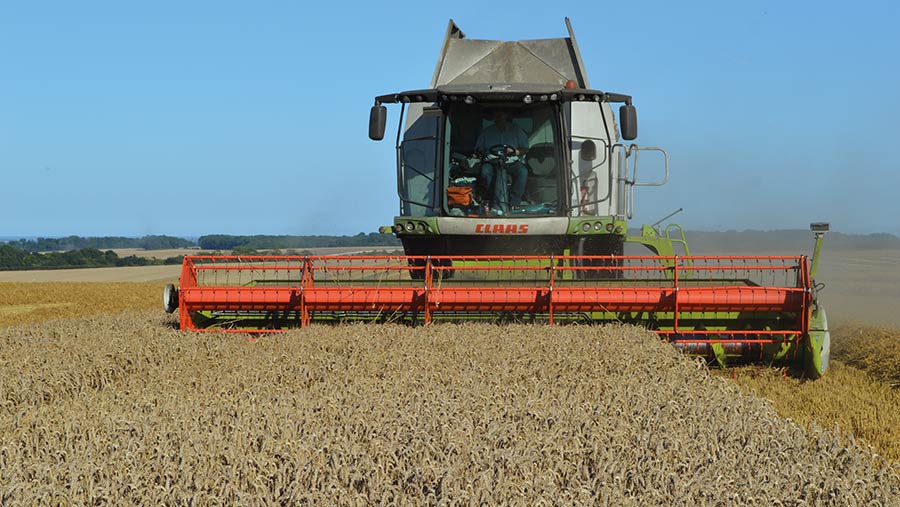Harvest 2021: Yields look good in North England and Scotland
 © MAG/David Jones
© MAG/David Jones Yields have been really pleasing in Scotland and the North of England, but the persistent cloud and drizzle further south means farmers risk losing out if they don’t get into crops soon.
Scotland
The August weather has ensured both a speedy and quality harvest for farmers, according to Robin Barron, general manager at East of Scotland Farmers. “It is one of the best harvests I can remember, and we are much further ahead than we usually expect to be,” he said.
Combines are well into Laureate and Diablo spring barley, with about 80% of the spring barley cut and showing exceptional quality, with nitrogen below 1.4%.
“While yields might be back by half a tonne on last year’s 6.85t/ha, we haven’t seen the perennial problems like pre-germination – this year there have been very few rejections,” said Mr Barron.
At the halfway point through the soft-milling winter wheats, grain is meeting specification with specific weights averaging 72-73kg/hl.
Combines are starting to enter spring oats, but it’s too early to get the full picture of the crop.
Tyne and Wear
In the North of England, the weather is not playing ball, according to Dave Young, farm trader at Grainco. However, harvest is on track for the time of year, and yields and quality have been pleasing across the board.
“Yields are generally very good – better than average for both first and second wheats,” he said, although proteins are a bit low on the quality wheats and because of the weather, crops are losing Hagberg levels.
“The oilseed rape yielded tremendously, with 4.9t/ha not uncommon. And prices are fantastic which has been a bit of a bonus. The winter oats yielded well with good bushel weights, but unfortunately the price is subdued,” he added.
On the spring malting barley front, yields have generally been good at 7.4t/ha, as have nitrogens at 1.5-1.6%. There has also been a lot of straw, which Mr Young said was needed.
East
In Norfolk, it’s been non-stop for everyone at Dewing Grain to cope with the drying demand, according to managing director Andrew Dewing. “It’s a difficult time, with continuous dull weather and drizzle most days, with nothing coming in at the correct moisture,” he said.
“It’s clear how few farmers are geared up for a wet harvest and they will lose more value in yield by waiting for a dry window than they will for combining now and having to pay the drying costs,” added Mr Dewing.
As of 31 August, there was about 40% of the harvest left. “In the past four years we were finished by the August bank holiday, but these difficult, damp harvests do happen,” he said.
Wheat yields have been adequate to okay on strong wheat land, with the light land achieving bigger yields.
“It was a good year for spring barley, but the stuff left in the field is likely to be suffering from the weather and may lose malting quality if there for much longer. Farmers need to get it cut and into store,” he said.
Midlands
Harvest has also been slow in Warwickshire, with farmers having to dash out in the afternoons to combine what they could at the right moisture.
Joe Scott, farm manager at Co-op Farms, Rugby, still has about 50-60% of his area left to cut. “The spring oats and triticale look fit and ready to go, but they aren’t drying enough. Everything seems stuck at 16-17%,” he said.
His Orwell winter barley yielded 9t/ha and his Skyscraper winter wheat did 9.5t/ha on light land, and he is happy with the yields. “The bushel weights were good in the barley, but the wheats were slightly down on proteins. Apart from the lack of sunshine it’s been pretty straightforward,” he said.
South
A dry break in conditions has seen grain filling at Cefra’s three southern stores pick up pace, according to farm grain origination manager Simon Wilcox.
“We’ve had about 10 days of dry weather in the South with many of our farmers making good progress over the bank holiday weekend. Moistures have improved in the wheat, down at 14.5-15%, back from the 16-17% we were seeing,” he said
Yields across the winter wheats have been variable dependent on local weather, drilling conditions and soil type. “We should be on for a five-year average, but probably no better overall,” he added.
For Group 1 milling wheats, quality has slipped with hagbergs drifting away and proteins struggling to get over 13%, while on spring barleys – largely Laureate and Planet – yields have been pushing 7.4t/ha.

